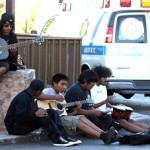As full-timers for the last few years, we’ve grown accustomed to being able to move with very little effort—we get up on the day we’ve chosen to leave, have breakfast, and then 2-3 hours later we are on the road heading for a new destination. After years of this behavior, imagine our surprise this year when we had to “summerize” our coach house before we could leave. Is “summerize” even a word? I’ve never heard of it, but do not know what else to call what we had to do. Maybe you campers that have seasonal cabins, park models, Texas rooms, Arizona rooms, etc. have a word for it—at Retama Village they just call it “shutdown.”
Most RVers (although, not so much us full-timers) are familiar with the process you must go through before you store your RV for the winter. Well, this year we stayed at our lot that we decided to purchase. It allows us to remain full-time RVers, but gives us a “permanent” place to stay. We chose to purchase a super-sized RV lot with a 12×20 foot “coach house” on it. Our coach house has a ¾ bath, washer-dryer, a small kitchen with a small sink (about like a wet-bar), refrigerator, and microwave (along with other small cooking appliances such as blender, NuWave convection oven, and slow-cookers) and a sitting room with tv, bookshelf, cabinet, heater (that looks like an old wood stove), and two large chairs that are also single hide-a-beds—in other words, we have our own little efficiency apartment (each owner in Retama Village has a different use for their coach house, from storage to wood shop; you can see a few of them here).
This year, because of the coach house, it took us a bit over 2-3 hours to get ready to leave. We had to deal with our mail and water/sewer/trash to cover our absence. Then we had to handle the utilities at the house by shutting off the water to the inside (leaving the irrigation turned on) and turning off any electricity that is not needed (like the refrigerator). We also had to make a determination of what to do with our air-conditioner. Some people leave them off, others leave them on, but at a high temperature. We decided that it would be best on certain items inside the coach house if we prevented the temperature from getting too high, so we set the thermostat to 85.
We also took precautions to prevent the water from evaporating from the p-traps so that there would be no issues (unwanted odors) when we return in the fall and to drain the excess water from the washing machine, but replace it with a solution that would not evaporate. We chose to use a liquid gray-water treatment that we’ve been happy with in the motor home.
Another precaution from owning in El Valle (the Rio Grande Valley in South Texas) is the possibility of hurricanes during the summer. The major precaution we have to take in this respect is to ensure all of our outside furniture (3-person swing, table with chairs, & umbrella, and decorations like pots and stuff) is moved into the coach house—so it will not be blown away (as long as the coach house remains…I suppose if those actually blow down, there is more to worry about than some furniture).
Finally, we take all the precautions we can to prevent any “critters” from moving in. We put some stuff around to slow down the fire ants. We closed up any gaps that mice or rodents can enter (we also used steel wool and moth balls since they do not like these things). We closed off any spaces where wasps might cause problems (like our 50-amp outlet). And we just generally sprayed for pests and bugs to slow down the progression of them moving in.
Out last item to take care of is to have someone keep an eye on the place…we hired someone to stop by and make sure the yard/landscaping is doing well, the air conditioner is still working, and no other surprises show up. It is worth if for the peace of mind; we don’t have to worry about unknowns and there is someone that can deal with emergencies if needed.
As you can tell by this description, when we decide to leave El Valle during the summer, instead of 2-3 hours of work, we spend 2-3 days getting ready. That was quite a surprise for us full-timers. But, the good news is that we only have to do this once a year (and it takes much less time to undo it all than it did to do…not sure why).

